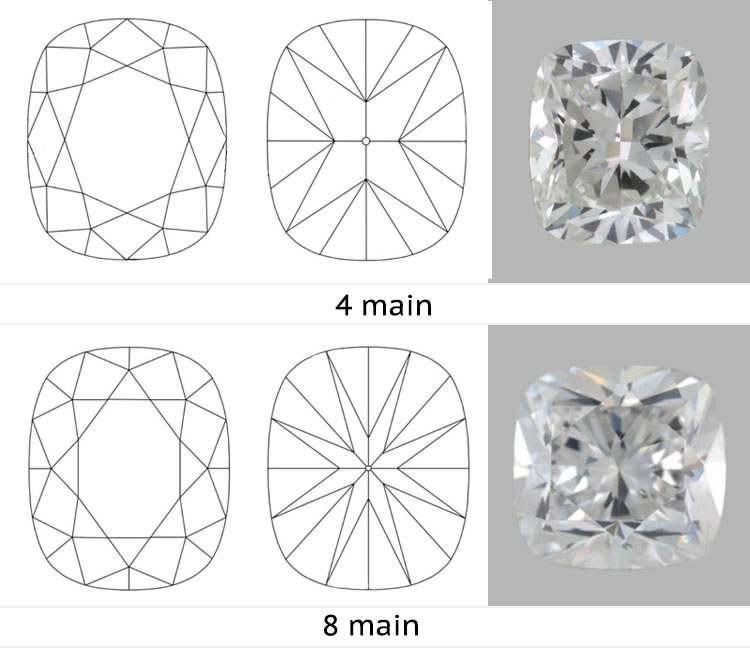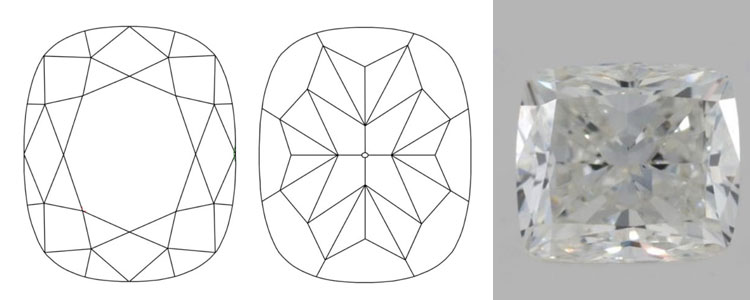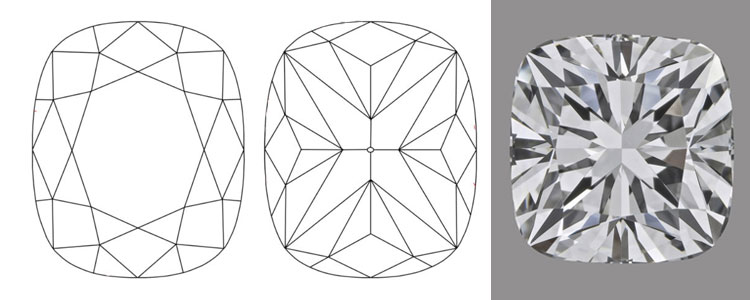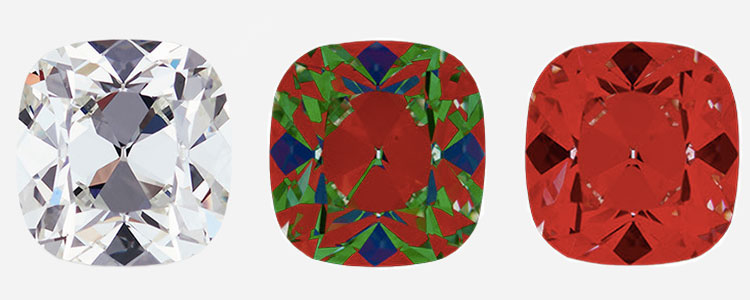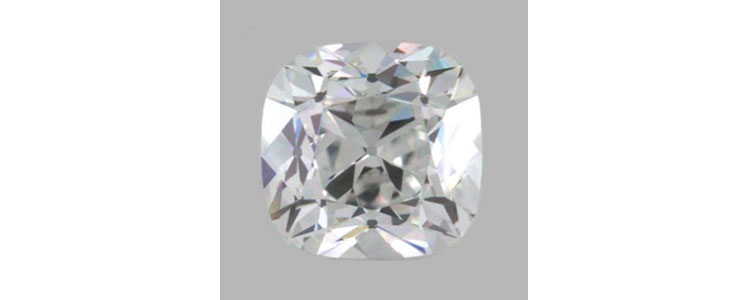
A cushion cut diamond is loosely defined as a square with rounded corners. A cushion can either be an antique-cut or a modern-cut with one of the earliest antique-cuts being the Old Mine Cut (OMC) diamond that first appeared in Brazil during the 18th century.
Like the round, princess, and oval cut diamonds that I have already written about, the cushion is a brilliant-cut diamond and you will find that this tutorial combines much of what you have learned from reading the other tutorials.
Like an oval, the cushion is not constrained in its length to width (L/W) ratio. However, because the cushion shape is meant to be a square, the ideal L/W ratio is 1.00 and like a princess cut, I recommend that you keep the L/W ratio between 0.95 – 1.05 to maintain a square shape.
Outside this range of L/W ratio a cushion becomes more rectangular and increasingly less symmetrical and less brilliant. These ‘pillow-shaped’ cushions retain more of the rough, so they command a lower price per carat than a square cushion. I recommend L/W ratios between 1.05 – 1.15 if you’re looking for a pillow-shaped cushion.
A cushion cut with L/W of over 1.2 will behave like an oval with an excessive bulge factor.
Cushion vs Round

Cushion cuts are not very brilliant despite being classified as brilliant-cut. Instead, cushions are known for their ability to produce big bold flashes of fire. Unfortunately, the vast majority of cushion cut diamonds on the market will neither be very brilliant nor fiery when compared to a round. Well-cut cushions do exist though so if you’re in the market for a cushion cut diamond, it’s very important for you to get to know the different types of cushions cuts available.
The Cushion Brilliant
The character of a cushion brilliant is largely influenced by the number of pavilion mains it has and you can get cushion brilliants with 4, 6, 8, and even 10 pavilion mains. The more pavilion mains a diamond has, the more it will sparkle with pin flash rather than bold flash.
The means 4-main cushions have fewer but larger facets than an 8-main cushion and the larger mains drive bigger and bolder flashes of fire. The trade-off is that a cushion with only 4 pavilion mains is not very brilliant.
The standard 8-main cushion brilliant shares the same 57-facet structure as the round brilliant and the Old Mine Cut. You will also encounter many cushion variations that have a different facet structure. These cushions are considered ‘modified’ with by far the most common modified brilliants having 4 pavilion mains.
Crushed Ice Cushions
In an effort to increase the brilliance of the cushion, additional facets were added resulting in a design known as a ‘crushed ice’ cushion. Crushed ice cushions can be identified by having 4 short pavilion mains that don’t reach the edge of the girdle. Because pavilion mains drive light return in a diamond, having pavilion mains that don’t reach the girdle edge results in crushed ice diamonds having weak overall light performance.
In a round, this would have resulted in a low cut grade, but because GIA does not grade cut in fancy shape diamonds, the vast majority of cushion cut diamonds have been cut for weight retention and not for light performance. This is why it’s estimated that 98% of the cushion cuts on the market are crushed ice, and after searching through hundreds of cushion cut diamonds to write this article, I believe this statistic to be more or less accurate.
Crushed ice cushions can look nice in pictures and videos because they exhibit very little light obstruction with almost all the light return being from the periphery and not from directly behind the observer. Crushed ice cushions also have a large number of internal reflections which reduces light leakage despite these diamonds typically being cut deep.
The reality is that a crushed ice cushion does not look very good at all when you compare it against any well-cut diamond. Unfortunately, with the prevalence of crushed ice diamonds on the market and no efficient way to filter out these diamonds, it can be very difficult for an average consumer to find a well-cut cushion. If you’re trying to look for a crushed-ice cushion, try to find one that has a balanced contrast pattern and good distribution of light return from the diamond.
The ‘X’ Factor
To remedy the problems found in the crushed ice cushion, a design called the ‘X-factor’ emerged, which extends the pavilion mains to the corners of the diamond. You will notice that in both the crushed ice and the X-factor, there are a few extra facets next to the pavilion mains. These additional facets increase the brilliance of the diamond. X-factor diamonds are a good choice if you like the look of a crushed-ice diamond but you are looking for a diamond with more brilliance.
The Hearts and Arrows Cushion
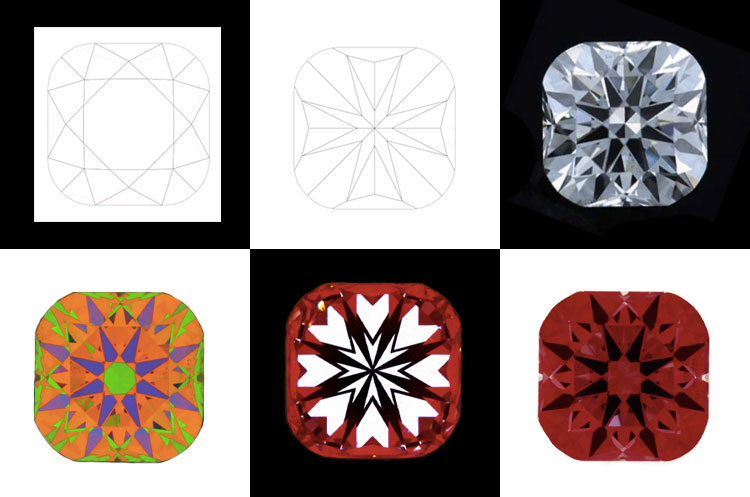
Hearts and arrows in a cushion can be evaluated very much like in rounds and the H&A pattern demonstrate the optical symmetry and cut precision that went into cutting the diamond. These cushions are also cut to meet AGS0 standard in light performance and can truly be called super-ideal cushions. If you don’t want to sacrifice light performance and need to have a cushion, then the H&A cushion is the answer.
The Old Mine Cut
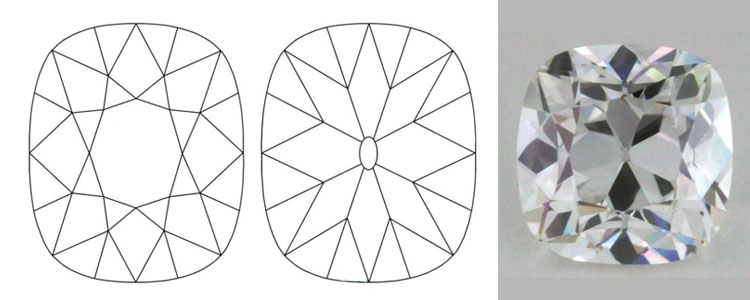
- Table size: less than or equal to 53 percent
- Crown angle: greater than or equal to 40 degrees
- Lower girdle length: less than or equal to 60 percent
- Culet size: slightly large or larger
GIA notes that in practice, only 3 out of these 4 criteria need to be met for the designation to be given, but you should also expect the total depth of an Old Mine Cut to be no greater than 70%. The requirement for a slightly large culet is primarily for visual effect, but eliminating a pointed culet also removes a durability risk.
We know from round diamonds that increasing the lower girdle length creates thinner arrows because the pavilion mains get smaller. So you can see that there is an implied requirement for an Old Mine Cut diamond to have large pavilion facets. The effect of having large pavilion mains is that Old Mine Cut diamonds have a ‘Maltese Cross’ look to it that GIA describes as having a “checkerboard” or “blocky” pattern.
Cushion lovers often call the Old Mine Cut a ‘chunky’ cushion. The chunkiness refers to their larger virtual facets that are caused by a combination of short lower girdles, a small table, and a high crown. With antique cuts increasing in popularity, vendors have developed modern versions of the Old Mine Cut. If the reason you have an interest in cushion cuts is because you wanted to maximize big bold flashes of fire then these modern antique cuts are your best bet.
The Kozibe Effect
There is an exception where you might want a combination of a high crown, small table, and a steep pavilion. In some antique cuts that have a larger culet, this combination of proportions causes the reflection of the culet to be visible through the crown facet. This is known as the Kozibe Effect and is usually an indication of hidden weight in a diamond. However, in antique cushions, it’s a matter of personal taste and many people specifically look for diamonds displaying this effect. A reflection of the culet in the crowns can be useful to reveal any asymmetry in the diamond.
How to Choose a Cushion Cut Diamond
Since there are so many different types of cushion cut diamonds, providing a general proportions guideline is more likely to be misleading than helpful. In my opinion, it’s far better for you to understand the general differences between the different types of cushions and the general behavior of facets. As with all fancy shapes, you should get an ASET or idealscope to check for light leakage, to make sure face up light performance is acceptable, and contrast pattern is appealing.
General concepts such as avoiding a diamond that is cut excessively deep or with tables that are larger than the total depth are good rules of thumb for all brilliant-cut diamonds and these rules also apply to cushions. I recommend looking for a total depth of not more than 65% for a 2-3% girdle. That said, every cushion should be evaluated on a case-by-case basis to take into account of personal preferences.
Conclusion
The world of cushion cut diamonds is full of different flavors. From H&A cushions that can match the brilliance of the round brilliant to the modern Old Mine cuts that have the most fire out of any brilliant cut diamond, if you love cushion diamonds there are plenty of choices available. If you’re looking for advice regarding a cushion cut diamond or you want help picking one out, please don’t hesitate to contact me for help.
